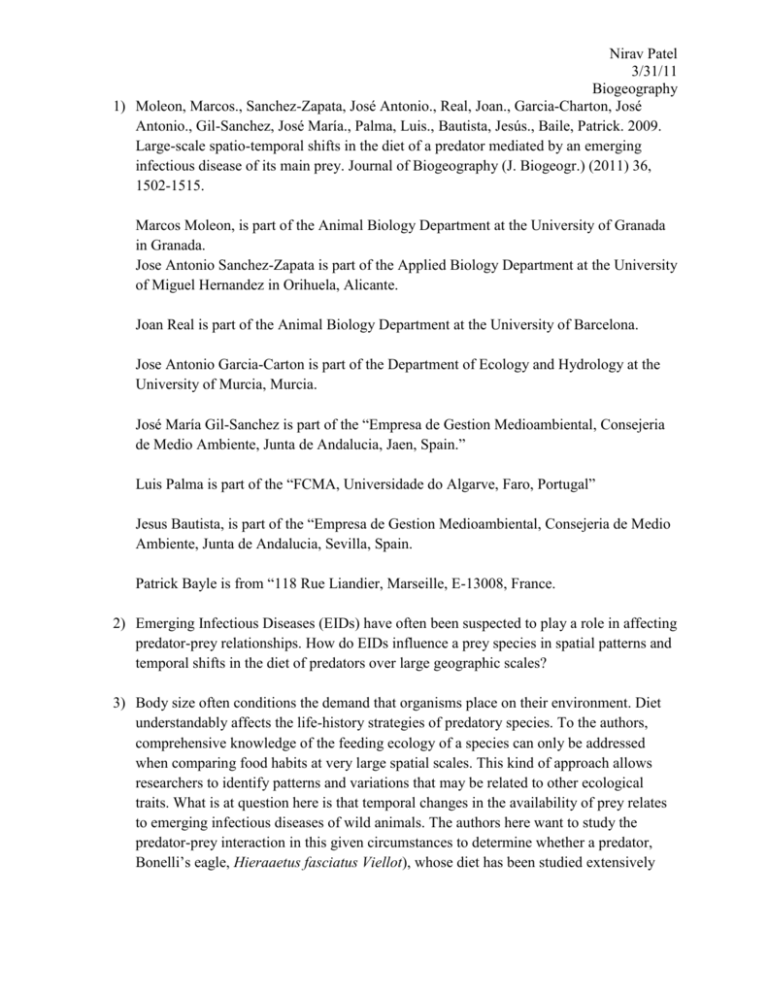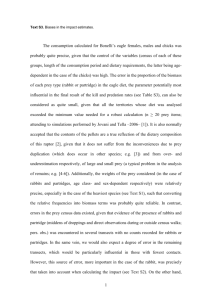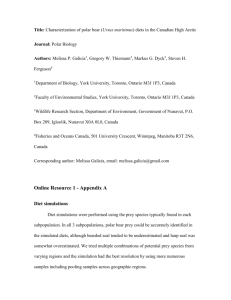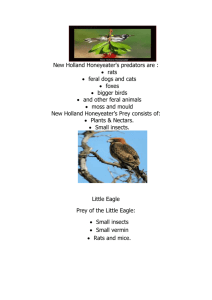Nirav Patel 3/31/11 Biogeography Moleon, Marcos., Sanchez
advertisement

Nirav Patel 3/31/11 Biogeography 1) Moleon, Marcos., Sanchez-Zapata, José Antonio., Real, Joan., Garcia-Charton, José Antonio., Gil-Sanchez, José María., Palma, Luis., Bautista, Jesús., Baile, Patrick. 2009. Large-scale spatio-temporal shifts in the diet of a predator mediated by an emerging infectious disease of its main prey. Journal of Biogeography (J. Biogeogr.) (2011) 36, 1502-1515. Marcos Moleon, is part of the Animal Biology Department at the University of Granada in Granada. Jose Antonio Sanchez-Zapata is part of the Applied Biology Department at the University of Miguel Hernandez in Orihuela, Alicante. Joan Real is part of the Animal Biology Department at the University of Barcelona. Jose Antonio Garcia-Carton is part of the Department of Ecology and Hydrology at the University of Murcia, Murcia. José María Gil-Sanchez is part of the “Empresa de Gestion Medioambiental, Consejeria de Medio Ambiente, Junta de Andalucia, Jaen, Spain.” Luis Palma is part of the “FCMA, Universidade do Algarve, Faro, Portugal” Jesus Bautista, is part of the “Empresa de Gestion Medioambiental, Consejeria de Medio Ambiente, Junta de Andalucia, Sevilla, Spain. Patrick Bayle is from “118 Rue Liandier, Marseille, E-13008, France. 2) Emerging Infectious Diseases (EIDs) have often been suspected to play a role in affecting predator-prey relationships. How do EIDs influence a prey species in spatial patterns and temporal shifts in the diet of predators over large geographic scales? 3) Body size often conditions the demand that organisms place on their environment. Diet understandably affects the life-history strategies of predatory species. To the authors, comprehensive knowledge of the feeding ecology of a species can only be addressed when comparing food habits at very large spatial scales. This kind of approach allows researchers to identify patterns and variations that may be related to other ecological traits. What is at question here is that temporal changes in the availability of prey relates to emerging infectious diseases of wild animals. The authors here want to study the predator-prey interaction in this given circumstances to determine whether a predator, Bonelli’s eagle, Hieraaetus fasciatus Viellot), whose diet has been studied extensively Nirav Patel 3/31/11 Biogeography within a continental scale in Europe, its main prey, the rabbit (Oryctolagus cuniculus Linnaeus), suffered many outbreaks of EID in parts of the 20th century. The Bonelli’s eagle is a medium to large sized raptor distributed irregularly throughout Southeast Asia, the Indian Subcontinent, the Middle East and the Mediterranean coast. The European population is often classified as endangered due the declined from the 1970s and the early 1990s. One of the main prey species is the rabbit referenced before. The rabbit population was reduced dramatically during its European range at the end of the 1980s and the beginning of the 1990s due to a disease called rabbit hemorrhagic disease (RHD). The outbreak resulted in the loss of 50-80% of the population. Given this background information the authors seek to describe geographical patterns in the diet of the Bonelli’s eagle across Western Europe and to analyze the long team trophic shifts that exist in relation to the disease-mediated in reductions in rabbit availability. Nirav Patel 3/31/11 Biogeography 4) The authors compiled published and unpublished information on the diet of the Bonelli’s eagle spanning the period 1968-2006 from Portugal, Spain and France; this is where 80% of the species is present. The studies that they used were ones that especially employed intensive direct observations, and observations of prey that were recently deposited in nests and resulting from pellet analysis. Due to the strong potential influences of rabbit density in the eagle’s trophic patterns we classified each sample territory as a before or after period in relation to rabbit density. Prey species were grouped into seven different categories. To examine the influence of RHD, fourteen territories of northern Spain were compared. Specifically what was tested for variations within the percentage of rabbits in the diet for two periods was down by means of nonparametric tests. Nonparametric procedures were used in order to look for variations within the trophic diversity between the two periods. 5) Most frequent prey for Bonelli’s eagle was the rabbit. There was a mean significant difference about one-third fewer rabbits in the diet. Thus, when there was the RHD Nirav Patel 3/31/11 Biogeography outbreak, rabbit consumption was reduced by a third. The circumstances put the Bonelli’s eagle at an intermediate position, because as sick rabbits suffering from RHD die suddenly, it is a greater availability of dying rabbits during the eagle’s breeding season that cannot explain that discrepancy. It was shown that the dietary geographical patterns of Bonelli’s eagles in western continental Europe seem to be driven mainly by the spatiotemporal variation in the abundance of rabbits and the local environmental features, which condition the presence and abundance of alternative prey species. 6) The study shows that an EID is able to disrupt the feeding ecology of a predator at the large scale in relation to the severe decline in the population of its principle prey species. The EID mediated prey reduction may therefore carry a lot of large scale consequences that provide implications not only for host-prey species but also for other species. Some factors constraining the validity of this argument may be the idea that predator diets may be conditioned by intrinsic or extrinsic patterns. 7.) The study’s findings support the ideas that strict guidelines and effective strategies must be developed in order to prevent the human-aided pathogen dispersal, which threatens diversity not only at the population and species level but also at the ecosystem and community level.







